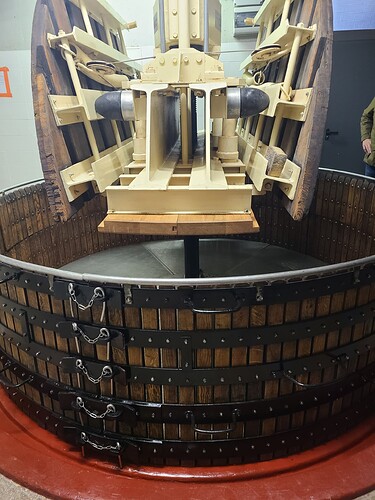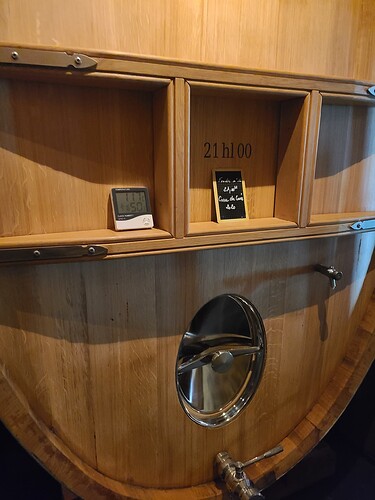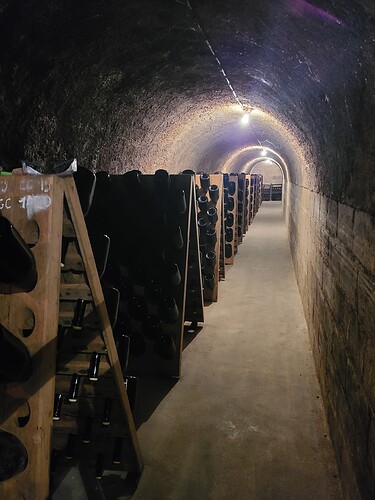Disclaimer: we might sell Vilmart champagnes soon.
I was in Champagne last week for business but my partners and I had also planned two domaine visits. The first one was at Vilmart.
We were hosted by Thomas who is a great host and seems to be an all-around nice guy. He took us on a quick tour of the winery and caves before sitting down in their lovely and modern tasting room.
This family-owned domain dates back to Désiré Vilmart in the 1870s. René Champs was the first “Champs” to take over the business (he was the son-in-law of Renan Vilmart). He was a carpenter by trade and this began the love affair between Vilmart and wood. Other than the fact that all wines are aged in wood (oak), you can also notice the use of wood throughout their winery and their offices.
Thomas started working at the domaine about five years ago alongside his father Laurent.
They own about 11 ha in around Rilly-la-Montagne. Their forefathers had the foresight to acquire parcels that were adjacent so all of their vineyards are within close distance of the chai. The 12 vineyards they own are situated over 2 villages only and all within 800 meters of the press (an old 1970s wooden Coquard press). I’m sure they thank their ancestors every harvest.
What is worth noting though is that the 11 ha of Premier Cru vineyards are planted to 70% Chardonnay and 30% Pinot Noir in an area where Chardonnay is more scarce.
About 80% of their vineyards have a South, South-East exposition overlooking Rilly.
All wines are aged in oak (foudre or fût), are fermented with purchased yeast and malo is blocked (not encouraged) through temperature control. All non-vintage wines also get a 50/50 split between reserve and base wines. They produce around 100,000 bottles per year and are RM. The only grapes they purchase is a tiny amount of Chardonnay that comes from a cousin with adjacent vineyards.
We walked the chai and caves so we could see the press, oenothèque and the many pupitres gracing their caves.
I used to drink a lot of Vilmart when in Montreal but since I’ve been in France, I’ve only had a couple of bottles here and there. It was great to reaffirm my love for their wines.
We made our way back to the tasting room and started with the Grande Réserve. This is 70% PN to 30% Chard and sees 10 months in oak foudres. The one we drank was base 2022 with 50% 2020-21 in the assemblage. The vines are in typical clay and limestones soil. There is a small proportion of “taille” in these wines (about 20%). The dosage is 6g/l. Stone fruit with nice acidity and a slight mineral touch on the finish. This shows great balance and hides the 6g/l dosage that just comes up as nice ripe peaches on the palate.
We moved on to the Grand Cellier. It’s 30% PN to 70 % Chard assemblage and same élevage in oak. Base wine is 2021 with 2019-20 as reserve wines. This sees twice as much time after disgorgement before coming to market. There’s a lot of freshness to this wine along with a cool slightly minty finish. The nose here is more Pinot dominant (red berries) on the nose but we do get the citrus hit on the palate.
Third candidate was the Grand Cellier d’Or 2020. This is 80% Chard to 20% PN. This is aged in oak cask (who see 4 to 6 harvests). The grape comes from the downslope of the Blanches Voies and the soil is mostly chalk. It sees 3 years on lees and 8 months after disgorgement. I think this was dosed at 7g/l. Apricot and honeycomb on the nose with some florals as well. This is full and round on the first palate with richness and breadth but again, the acidic line cuts through it starting on the mid-palate and it ends on spices (gingerbread).
Coeur de cuvée 2016 comes from old vines higher up in les Blanches Voies (80% Chard, 20% PN). The 220L casks see 2 to 4 harvest and again, the wine spends 10 months in oak. This sees 5 years on lees and hits market 2 years after disgorgement. Wonderful wine. Ripe citrus, florals and some brioche on the nose. Good richness and complexity again and more mineral than the Grand Cellier d’Or.
The Blanc de Blancs 2013 is all Blanches Voies (harvest was October 5th in 2013). Oak casks with only one harvest on them. 7 years on lees and 4 years post-disgorgement. The first vintage of this was 2009. They only produce around 3,000 bottles. Slight élevage on the nose along with clémentine and florals. Ripe citrus and slight cream on the palate. This is more delicate than the prior wines and display more mineral freshness.
Cuvée Rubis is 90% PN (15% still wine) and 10% Chard with a base of 2022 and 2020-21 reserve wines. This sees 10 months in foudres, This is a tad austere but in a good way. Ripe cherries and vibrant on the palate. This is a versatile wine.
Émotions 2015 is another story. I read some concerns around this cuvée on WB but it showed well here. 40% Chard, 60% PN. 220L oak casks, 5 years on lees, 3 years post disgorgeement. This shows more tension than the Rubis: sour cherries and strawberries on the nose. The palate brings additional depth with some florals and cinnamon/clove action going on. Medium finish.
Before the Ratafia, which was quite lovely, we finished with the Coeur de Cuvée 2003. I guessed 2010 on this because of the depth and complexity but also freshness. No way I thought this was 20 years old. Great wine with plenty of Maillard golden goodness.
This was a great visit and we are looking forward to carrying these wines.




